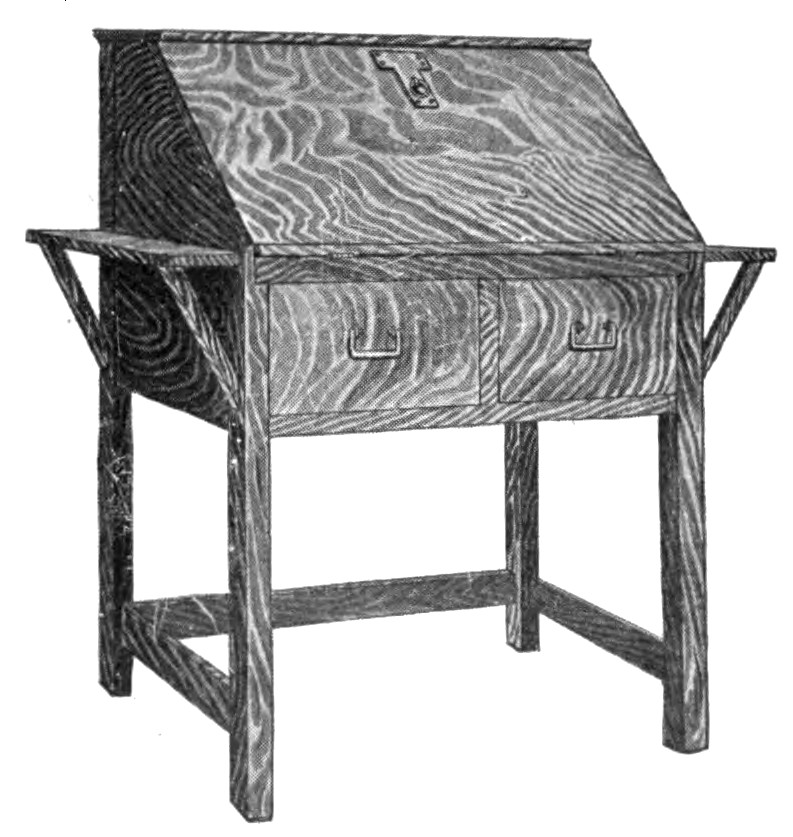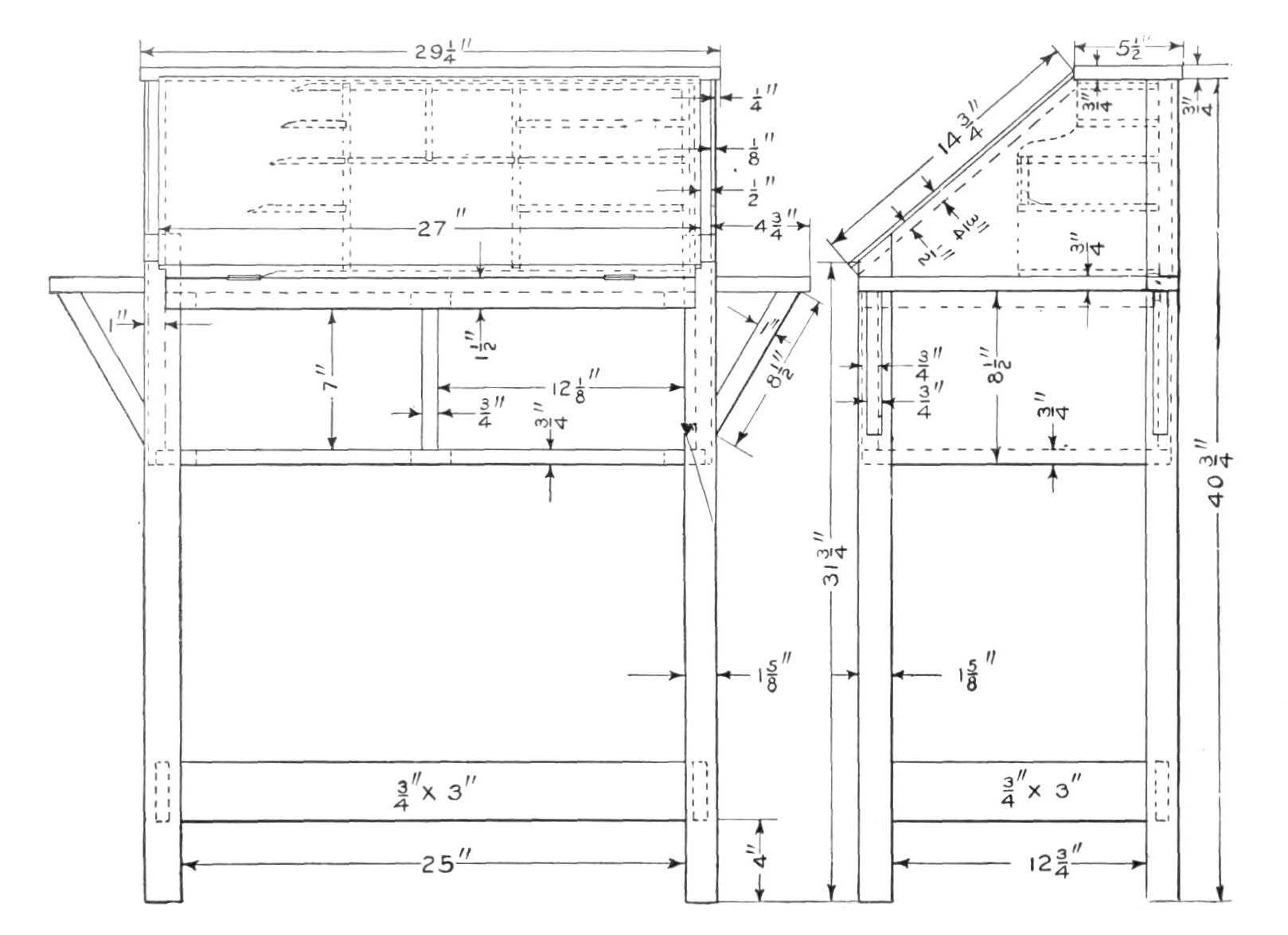| AN
OAK WRITING DESK

Writing Desk Complete
For the writing
desk
shown in the accompanying picture the following stock will be needed.
The thicknesses of all the pieces are specified. On the legs the
widths, too, are specified. Quarter-sawed white oak is the best wood
to use, and it should be well seasoned and clear of shakes and other
imperfections.
STOCK
BILL
2 front posts, 1
5/8 by 1
5/8 by 34 in., S-4-S., oak.
2 back posts, 1 5/8
by 1
5/8 by 42 in., S-4-S., oak.
2 lower side rails,
3/4
by 3 1/4 by 15 in., S-2-S., oak.
1 lower back rail,
3/4 by
3 1/4 by 27 in., S-2-S., oak.
2 sides, 3/4 by 9
by 14
in., S-2-S., oak.
2 sides, 3/4 by 10
1/2 by
14 in., S-2-S., oak.
1 back, 3/4 by 9 by
28
in., S-2-S., oak.
1 back, 3/4 by 10
1/2 by
26 in., S-2-S., oak.
1 top, 3/4 by 6 by
30
in., S-2-S., oak.
1 lid, 3/4 by 15 by
28
in., S-2-S., oak.
2 side shelves, 3/4
by 5
by 16 in., S-2-S., oak.
4 braces, 3/4 by 1
1/4 by
9 in., S-2-S., oak.
1 bottom of case,
3/4 by
16 by 28 in., S-2-S., oak.
INTERIOR
1 piece, 3/4 by 16
by 27
in., S-2-S., oak.
4 drawer and case
bottom
supports,
3/4 by 2 1/2 by
28 in., S-2-S., oak.
8 drawer and case
bottom
supports,
3/4 by 2 1/2 by
16 in., S-2-S., oak.
4 drawer guides,
3/4 by
3/4 by 16 in., S-2-S., oak.
DRAWERS
2 front pieces, 3/4
by
71/2 by 13 in., S-2-S., oak.
4 side pieces, 3/8
by
71/2 by 16 in., S-2-S., poplar.
2 back pieces, 3/8
by 7
by 12 in., S-2-S., poplar.
2 bottom pieces,
3/8 by
16 by 12 in., S-2-S., poplar.
PIGEON
HOLES
1 bottom, 3/16 by 7
1/4
by 27 in., S-2-S., poplar.
1 top, 3/16 by 4
1/2 by
27 in., S-2-S., poplar.
4 verticals, 3/16
by 7
1/4 by 10 in., S-2-S., poplar.
1 vertical, 3/16 by
4 1/2
by 4 in., S-2-S., poplar.
5 horizontals, 3/16
by 7
1/2 by 9 in. S-2-S., poplar.
2 horizontals, 4
1/4 by 9
in., S-2-S., poplar.
DRAWERS
IN PIGEON HOLES
2 front, 3/8 by 2
1/4 by
9 in., S-2-S., poplar.
4 sides, 3/16 by 2
1/4 by
7 1/4 in., S-2-S., poplar.
2 backs, 3/16 by 2
1/4 by
9 in., S-2-S., poplar.
2 bottoms, 3/16 by
7 1/4
by 9 in., S-2-S., poplar.
Begin work by
cutting the
posts to length and shape. Having done this, lay out the tenons on
the lower rails so as to have the required distances between the
shoulders, and then cut them. Now cut the parts to be worked into the
frames that support the drawer and bottom of the case, and glue them
properly. While this is drying, the other parts of the case may be
laid out and shaped. It is intended that the sides of the case shall
splice on the edge of the bottom
of the pigeon
hole case.
In this manner the side shelves will cover the joint on either end.
The back may be made up into one solid piece. Make the side pieces of
the case long enough to be housed into the posts about 3/8 in. at
each end.

(Click for larger image)
The shelves at
the ends
of the desk should be fastened after the frame is put together and
before the bottom of the case for the pigeon holes is fitted and
fastened. In so doing the shelves may be fastened from the inside of
the case. The angles of the braces are 30-60 deg. It will be noted
that the edges of the lid are rabbeted. Another way is to have the
lid large enough to fit entirely over the sides of the case and
change the slope to correspond.
The drawers may
be made
next. The fronts should be of oak, but the other parts of yellow
poplar. An examination of an ordinary drawer will show the manner of
construction.
Make the frame
of the
pigeon holes of h in. yellow poplar. The drawing shows an arrangement
entirely independent of the sides of the desk so that the frame can
be made and slipped in place after the finish has been put on. Two
drawers are shown. These are faced front and back alike so as to
secure as much room in the drawer as possible.
In the
finishing, the
poplar wood should be finished with white shellac in the natural
light color of the wood. For the oak parts the following is
appropriate for this design: Apply one coat of green Flemish water
stain. When this has dried, sandpaper lightly until the raised grain
has been removed, and apply another coat of stain diluted one-half
with water. When dry, sand lightly and apply a very thin coat of
shellac. Sand lightly and apply a coat of dark filler, natural filler
colored with lampblack, according to the somberness of the finish
desired. Upon this put a coat of orange shellac. After this, put on
two coats of a good rubbing varnish. Rub the first coats with curled
hair or haircloth and the last with pulverized pumice stone and raw
linseed oil or crude oil.
|

